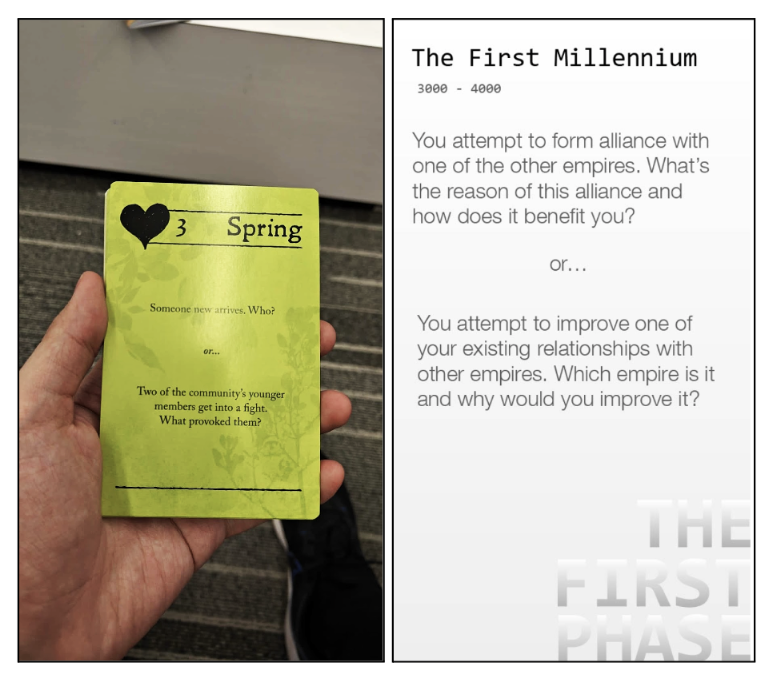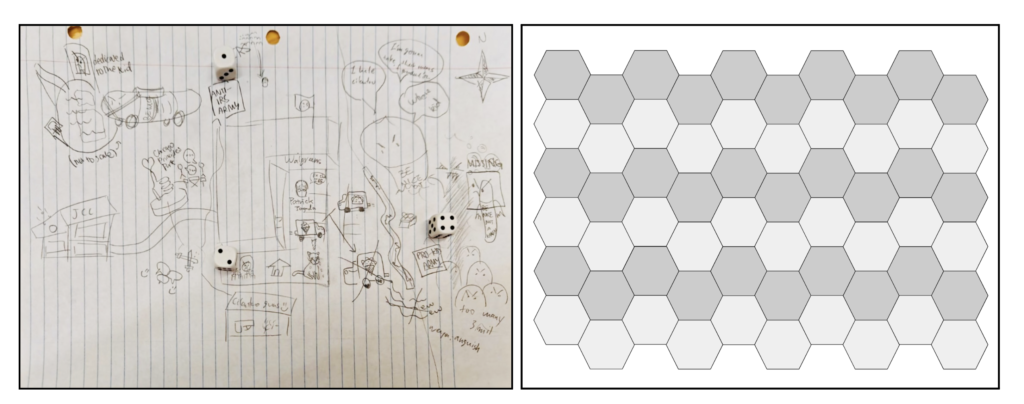All our times have come
Blue Öyster Cult, “(Don’t Fear) the Reaper”
Here but now they’re gone
Seasons don’t fear the reaper
Nor do the wind, the sun or the rain
We can be like they are…
Phase One: CONCEPT & EARLY RULES/MECHANICS
(written by Sanaiya)
Welcome to our progress post (or I like to call it, the “prog blog”) for Don’t Fear the Reaper. As the title suggests, DFtR is a tabletop-themed nod to the inevitability of death—much like the best card/Belonging Outside Belonging game to ever emerge from a burlap sack, The Quiet Year. Playing TQY at the very beginning of our game-making journey got us hooked on the freedom a TTRPG gifts to its players.
Listed below are the more specific aspects of our TQY experience we found inspiring—and the ways we turned these aspects into our own “things.” This little collection of call-and-response bullet points became the conceptual foundation for Don’t Fear the Reaper.
- Timelines/The Inevitability of Death: Only one thing is for certain in The Quiet Year: it’s spring, and the drawing of cards symbolizes the passage of time: spring, summer, fall, winter.Your entire community will die as soon as one fateful winter-phase card is drawn. We wanted to transfer this apocalyptic premise to a galactic setting, where players could act as leaders of their own spacey civilizations. So, it made narrative sense to transform TQY’s four seasonal phases into three millennia phases: 3000-4000, 4000-5000, and 5000-6000 CE. After all, it takes a long time, sometimes thousands of years, for interplanetary empires to develop—but a 30-minute time constraint means having 3 phases rather than 4 is the way to go.

- Map Out Your Concerns: TQY advertises itself as a cartography game, so players have the chance to construct a map of their own civilization—from scratch. Well, why not have several civilizations (one for each player) war against each other instead? That sounds more realistic than genuine collaboration, right? So, yes: we adored the idea of a map as a “shared playspace” but also abandoned its collaborative nature. Instead of bonding over a blank map, players air grievances over a 60-hexagon grid for the most amount of territory.

- Little Skulls Everywhere: Speaking of “airing grievances,” if you ever get pissed at another player during your TQY sesh, tell ‘em with a contempt token/skull meeple. Don’t Fear the Reaper offers players a more actionable way of expressing their anger: the “arms race” mechanic. Anytime another player pisses you off, try starting an arms race with them, building up your military arsenal so you can eventually wage battles with them for territory. Military might is represented by the # of rocket tokens/meeples a player has in front of them, and one can be played every turn…but doing so can be costly.

Phase Two: PLAYTESTING & REFINED RULES/MECHANICS (written by Andrew)
With these ideas in mind, we drafted the first versions of a deck of cards spanning three millenia, with 10 cards in each thousand years. Building on this chronological progression and inspired by The Quiet Year’s gradual descent into darkness, the cards in Don’t Fear the Reaper seek to take the players on a galactical tale that, with the passage of time, becomes gradually filled with increasing dread, paranoia, violence, and all sorts of awesome negativity.
The first playtest of our prototype was, in a sense, both a playtesting session and a game dev session – we found a lot of rules, mechanics, details, etc. that were glossed over during our initial phase of design, including things like the starting setup, the relationship system, and the means to wage battles wabatrs and visually represent them. (After all, my Domino’s™️ Pizzacracy didn’t build up a huge arsenal for nothing!)

After this round of refinement, we hope to continue our project of making Don’t Fear the Reaper a game of emergent narrative about a Galaxy facing both an unknown, extragalactic dread and far-from-stable internal strife. Some of the things we developed/polished include:
- “Character” sheets (with pre-made ones ready for playtesting in class, as we would prefer the players spend more time experiencing and examining the narrative and the set of rules/mechanics that support it. The pre-made civilizations feature things such as a white-board democracy (take every single word of it literally), glob, and of course Domino’s™️.
- As mentioned above, a detailed system of dice rolls to determine starting relationships. Since the game starts with civilizations already having centuries, if not millenia, of history behind them, it would make more sense for the narrative to start with predetermined relationships.
- BATTLES! We came up with a system in which the “arms race” that are used to express contempt can be translated into actual conflicts between players, which also involves dice rolls. The size of your arsenal becomes a modifier to a d6 roll, and the player with the bigger roll wins. The difference between the two players’ scores then becomes the “bargaining power” with which territory or even technology can be seized in post-battle treaties of power imbalance.
We also came upon the name, Don’t Fear the Reaper, courtesy to Cyberpunk 2077 and its brilliant ideas of naming missions after songs. It was quite a bliss to my Spotify playlist for sure.
This pretty much concludes the progress blog for our project so far. We are looking forward to feedback, criticism, and all sorts of comments during our in-class playtesting today!
Phase Three: ITERATION OF GAME AND UPDATES OF MECHANICS (written by Yiming)
We received helpful feedback from our fellow game devs about our TTRPG, including but not limited to:
- Cards should promote actions between players
- If rocket tokens are free for everyone to take during each round, what’s stopping one from taking them?
- In addition, players want to wage wars on each other, but not allowed to do so, why is this?
- “This feels like a reskin of The Quiet Year” – Eren
- “The rulebook is deficient in building a narrative space for the player” – Erin
- “The game should encourage simmering tensions between the empires” – Ash
We think all of them are valid criticisms for our game. I have a rather vague picture of our game’s setting: a far future galaxy where civilizations have acquired advanced technology such as faster-than-light aircraft traveling speed. Civilizations receive this ambiguous piece of information that a species called the reapers (thanks, Mass Effect and the “(Don’t Fear) The Reaper” song) will arrive in the galaxy in the year 6000. But then what happens? No one knows.
In a way, we want to set up the beginning and the ending of the story that the players will tell through our game, in a way similar to The Quiet Year, but now, our game lacks certain actions and a background story that sets us apart from The Quiet Year. Ash’s and Eren’s criticisms are especially helpful for us to iterate our game mechanics – mostly, the cards – towards this direction.
Mainly, we updated:
- our game cards so that they become more engaging and actionable. For example, we have a card that says an empire is having a mental health crisis and asks what the player would do. But instead of just asking, we changed the design to contain more actions: because of the crisis, the population on a hex (which means one unit of their territory) goes insane and thus the player loses that part of their territory.
- our War and Conflict mechanics. In the past, empires can only wage war if they draw the “conflict” card. Now, as long as their borders touch, they have military power, and their relationship is more hostile than friendly, they are allowed to start a war. The winner gets to take a hex of the other empire’s territory. In this way, the players can wage war when they want and when the conditions are met.
- Conflicts, on the other hand, can only be started when the “conflict” card is drawn. Differs from wars, to start a conflict, you don’t need the borders to share. Quoting from our rulebook, “[H]owever, conflicts are small-scale exchanges of firepower, thus yielding to nothing, unlike wars where territory can be won.”
- Relationships between empires now play a part in the mechanics and story that only when the relationship is less than ideal can a war be started, as mentioned above.
- Apart from the War token, we also added a Capital token to give the players a way to negotiate between each other about trading.
- We completely re-designed the rulebook such that now it’s a booklet, which is more suitable for reading. We also re-written the rules with a governmental and legal tone to further set up the style of the story.
Ultimately, we want to produce an existential experience to the players. They can either fight with each other to take over lands, or cooperate with each other for a better future until the reaper comes, but none of this would matter when the reaper arrives, which is when the game suddenly ends. We want to prompt the players to think that, knowing that the world might end one day, or not, what are the things that matter the most.

GLOB FTW